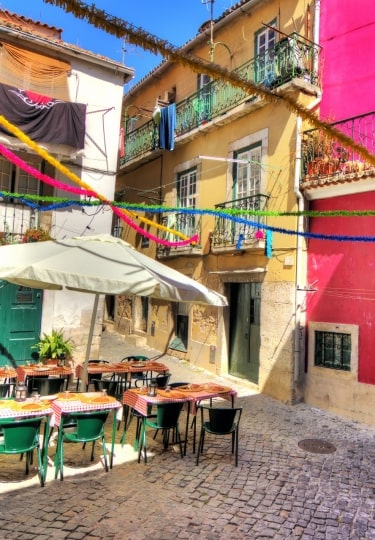Sprawling across seven hills, Portugal’s capital city is an irresistible medley of tiled façades, centuries-old architecture, and calçada (mosaic) coated streets. Yet, despite their similarities, the best neighborhoods in Lisbon all maintain unique personalities—often defined more by their historic culture than the current 24 civil parishes’ boundary lines.
As one of Europe’s oldest cities, believed to have been founded around 1200 BC, Lisbon’s neighborhoods (or barrios, locally) range from maze-like Moorish quarters to more modern precincts rebuilt in grids and squares. It’s easy to explore on foot with comfy shoes, or by the iconic yellow vintage trams, which makes hopping between the city’s most beguiling barrios a breeze.
Whether you’re keen to sightsee, shop or savor the ever-growing culinary scene, these are the best neighborhoods in Lisbon to explore.
Alfama
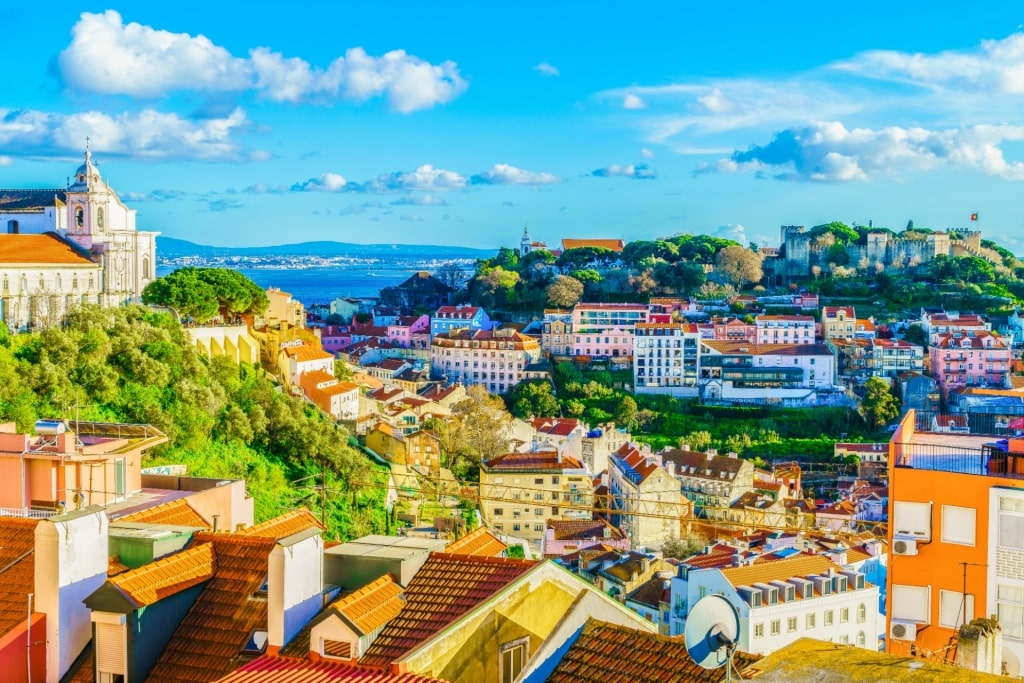
Alfama
Alfama, the city’s most emblematic and historic barrio, is one of the best neighborhoods in Lisbon to sneak a peek into traditional life.
In these lanes, where the scent of sardines and the haunting melodies of fado—the traditional melancholic music that Portugal is known for—wafts through the air, you’ll find a Lisbon time capsule.

Alfama
Having survived the 1755 earthquake which devastated much of the city, the medina-like cluster of whitewashed cobblestone streets, aged architecture, and tiny tascas (small typical restaurants) are a delight to ramble among.
The neighborhood’s history dates back to the eighth century and the period of Moorish rule, yet many of the grandest landmarks you’ll spot were built later, following the Reconquista, when the Moors were driven out of the Iberian peninsula.

Sé
One of the best things to do in Lisbon is to visit Sé, the city’s cathedral, an impressive 12th-century affair with Roman, gothic, and baroque elements, highlighting the various reconstructions over the years.
Another religious monument worth visiting is the 17th-century National Pantheon, the final resting place for some of Portugal’s most celebrated personalities.

Alfama
After ambling up the steep streets with plenty of photogenic pauses en route, you’ll reach the 11th-century Castelo de São Jorge. One of the best places to visit in Portugal, it crowns the city’s oldest quarter.
The panoramas across Lisbon and the Tagus River from here are spectacular. Constructed as a fortress—the last mark of the Moorish stronghold—the defensive building briefly became a royal palace before returning to a military role.

Castelo de São Jorge
As you roam the cannon-adorned walls, numerous towers, and archaeological museum, you’ll be retracing the dramatic days of Portugal’s Middle Ages.
Alfama is also home to some of Lisbon’s finest museums, allowing a deeper dive into Portugal’s cultural scene. At the interactive Museu do Fado, you’ll have the chance to learn more about the music’s roots and stars, such as Amália Rodrigues.
For literary genius, explore the rooms of Casa dos Bicos, a space now dedicated to Portugal’s most famous writer, José Saramago.

São Vicente
Beyond Alfama, the barrio’s lines blur into São Vicente, where the magnificent Monastery of São Vicente de Fora, a vast and impressive monastery complex, is well worth the detour.
Baixa

Praça do Comércio
Lisbon’s downtown Baixa, covering the valley area between waterfront Praça do Comércio and upmarket Avenida da Liberdade, is a stark architectural contrast to the Alfama.
Ravaged by the 1755 earthquake—one of the most destructive ever witnessed in Europe—the neighborhood was rapidly rebuilt in a grid and square style by Marquês de Pombal, the then prime minister.
With plenty of pretty squares and some of the city’s busiest streets, nowadays, Baixa is one of the best neighborhoods in Lisbon for shopping, strolling, and dining.

Praça do Comércio
Facing the Tagus River, Praça do Comércio, the largest square in Lisbon, serves as a grand welcome to the city. Pre-earthquake, the Royal Palace dominated this area before the square was reimagined as a gateway port for merchant traders.
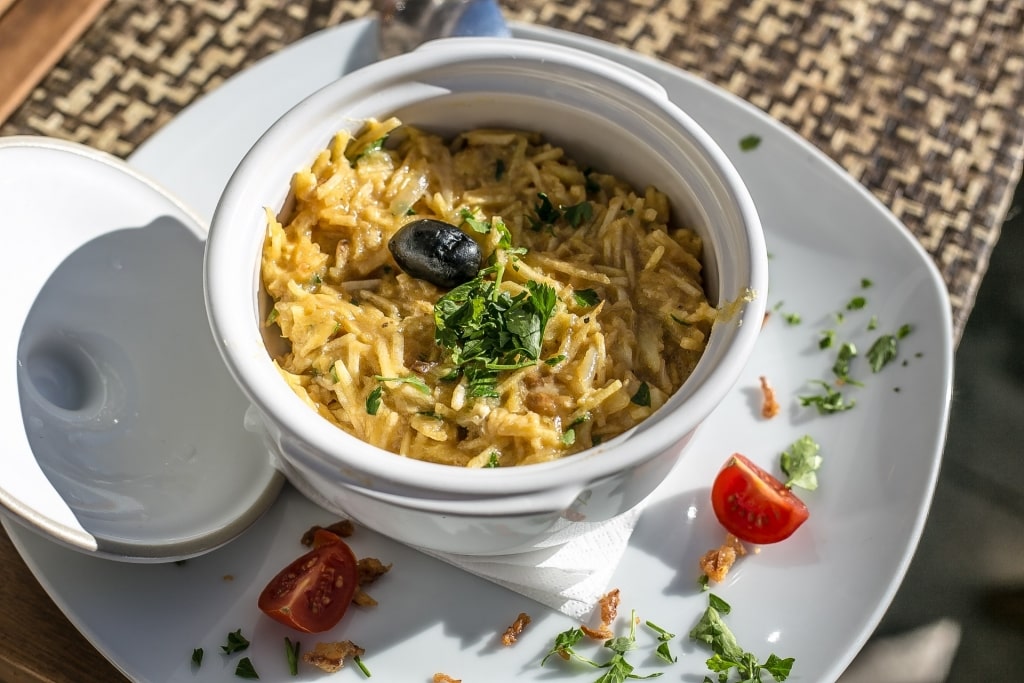
Bacalhau
Flanking three sides of the square are imposing, lemon-hued buildings in the Pombaline style. Beneath the porticos, cafés perfect for people-watching spill out, while a cluster of museums provide plenty of insight.
At Lisboa Story Centre, you’ll be whisked through the city’s major historical events, while the Bacalhau center is dedicated to Portugal’s beloved national dish, salted cod fish.
Passing under the imposing Arco da Rua Augusta—the far-reaching views from the top some of the city’s finest—you’ll reach Lisbon’s main pedestrian thoroughfare of the same name.
Here, traditional stores selling cork products, port, and tinned sardines jostle with souvenir shops and swanky restaurants. It’s a real melange of Lisbon’s past and present and often the city’s most crowded point.

Praça Dom Pedro IV
Distinctive Praça Dom Pedro IV, famed for its wave-like tiled floor using Portugal’s traditional calçada pavement stones, is another of the city’s main meeting points. It’s often called Rossio, and you’ll find plenty of typical restaurants enveloping the praça.
For a sweet and alcoholic taste of Portugal, head to A Ginjinha, a vintage hole-in-the-wall bar serving Portugal’s signature cherry liquor. It tastes even better when savored from a chocolate cup.
Beyond Rossio, Avenida da Liberdade—considered by some a different neighborhood—links the old city with the new. This grand, Paris-inspired boulevard is home to the city’s most premium and upscale boutiques and stores, ideal for a spot of luxury retail therapy.
Belém

Belém
Around six miles from downtown Lisbon, the riverside district of Belém has long been an important part of the city, first as a royal residence and later as the home of the President.
But it’s the two World Heritage–listed attractions that make this the best neighborhood in Lisbon for architecture aficionados.
On the waterfront, standing guard since the 16th century, the ornate Belém Tower was both a defensive fort and a key location for welcoming Portuguese explorers home.
Accessed by a bridge due to high tides surrounding the tower, the stonework and carvings of the four floors are captivating, as are the river views from the turrets.

Jerónimos Monastery
Built at the height of the Portuguese renaissance, the tower is a prime example of the Manueline-style architecture that flourished, as is the Jerónimos Monastery, the second UNESCO attraction in the district and is one of the most beautiful places in Portugal.
Magnificent from the exterior and interior, the more than 500-years old monastery has served various purposes since the original monks vacated.
If you choose to venture inside, you’ll find a sense of calmness among the elaborate cloisters and webbed vaulted ceilings, the architecture a true testament to Portugal’s prime position on the world stage in bygone years.

Padrão dos Descobrimentos
Other attractions in Belem include the Padrão dos Descobrimentos, a monument to Portugal’s colonizing Age of Discovery, and plenty of green spaces, including the Tropical Botanical Garden.
Slightly to the east, the futuristic MATT (Museum of Art, Architecture, and Technology) respectfully rises from the riverbank, providing a modern space exhibiting all things contemporary and topical.

Pastel de nata
After getting your fill of impressive architecture, it’s time to turn your attention to Portugal’s most famous sweet treat, the Pastel de Nata. One of the best desserts in the world, these flaky and delicious custard tarts hail from the monastery, and Pastéis de Belém serves up thousands of the pastries daily.
Since 1837, this cavernous cafe has sprawled, now spread across countless rooms in the maze-like interior. While the queues are often long, both for the dining room and takeaway counter outside, there are hundreds of seats, meaning the line usually moves quickly.
Read: What to Eat in Lisbon
Chiado & Bairro Alto
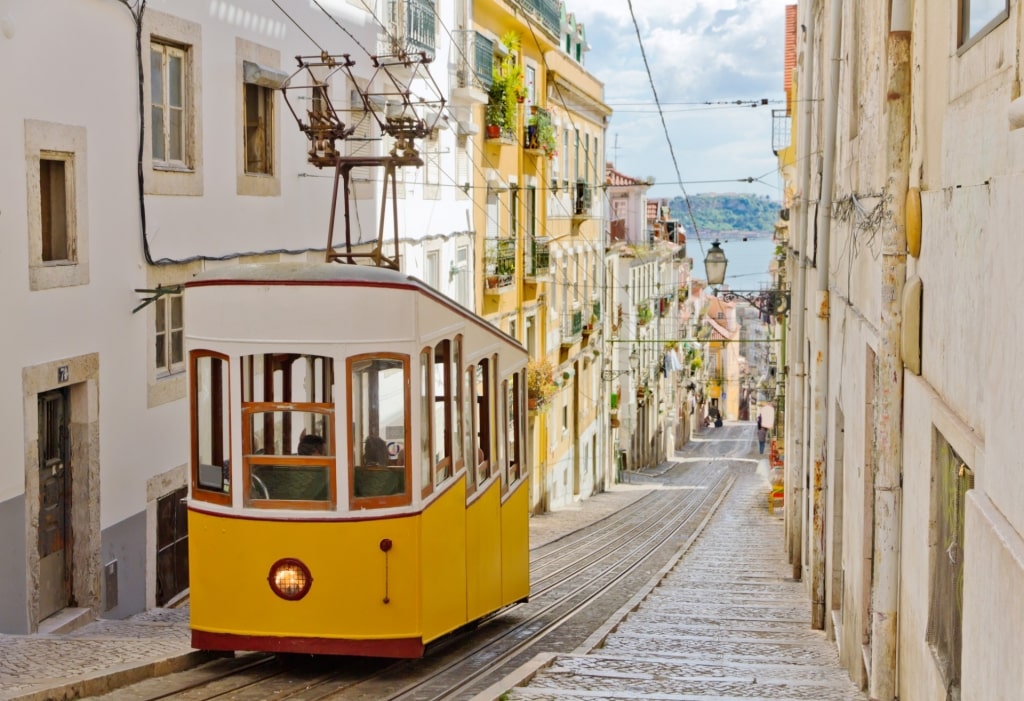
Bairro Alto
Chiado, and neighboring Bairro Alto, are the best neighborhoods in Lisbon in which to linger over a cocktail or a coffee, and people-watch while enjoying the soundtrack of street performers.
Reachable from Baixa on foot, or by riding the Elevador de Santa Justa—a wrought-iron public lift inaugurated in 1902—this elegant quarter is awash with grand cafés and well-respected stores. After dark, Bairro Alto assumes a different character as the epicenter of Lisbon’s lively nightlife.

Convento do Carmo
There’s plenty to see by day, though. Stepping out of the elevator, you’ll be greeted by the roofless arches and remains of Convento do Carmo. Heavily damaged by the earthquake, it’s a miracle any of the 14th-century convent remains.
As you walk among the now open-air cracked pillars and sturdy outer walls, you’ll get a sense of the sheer terror the city was subjected to in 1755. Inside, there is also a miniature archaeological museum holding some of the city’s recovered ancient discoveries.
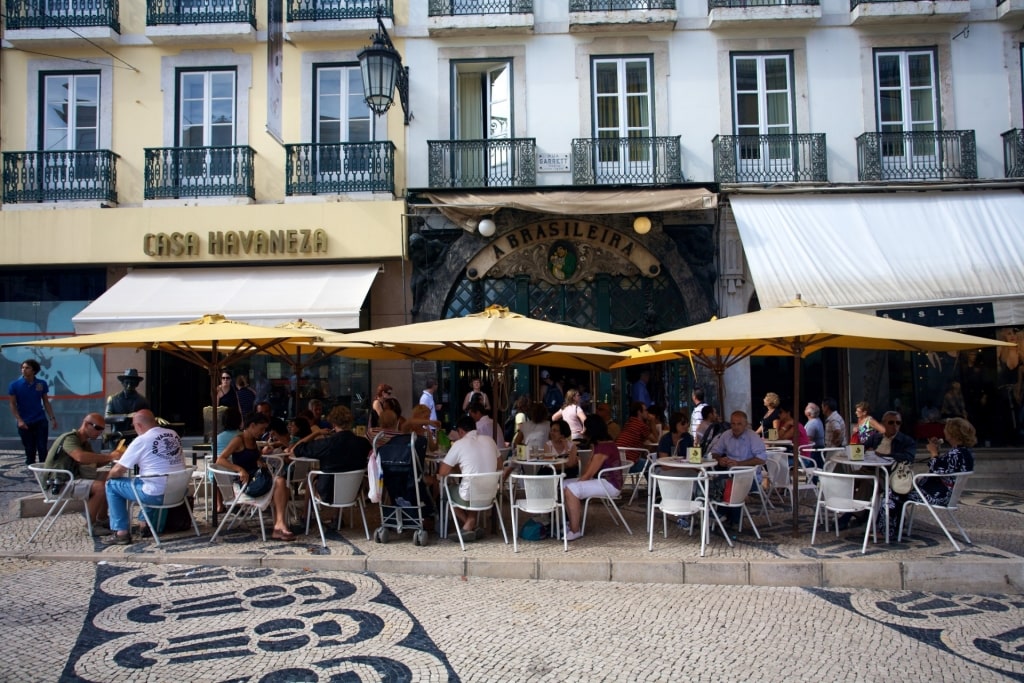
A Brasileira Photo by Dirk Olbertz on Flickr, licensed under CC BY 2.0
One of the most famous spots for a coffee is A Brasileira, a grand art-deco cafe that has been a go-to for creatives since 1905. While the interior is a decorative dream, the terrace is just as tempting for watching the world go by, as writers have done for years.
A statue of Fernando Pessoa, Portugal’s most celebrated poet, sits in front of the café, and Bertrand bookshop, regarded as the oldest bookstore in the world, is just beyond, adding to the literary credentials.

Miradouro de São Pedro de Alcântara
For a final pièce de résistance, linger at Miradouro de São Pedro de Alcântara, a garden viewing platform with some of the best vistas in the city.
Príncipe Real

Príncipe Real
Well-heeled Príncipe Real, situated above Baixa and beyond Bairro Alto’s bar-heavy streets, is the place to head for premium dining, trendy art galleries, and independent boutiques.
Most notable for its grand townhouses and architecture, Príncipe Real is also home to plenty of leafy green spaces, including the city’s Jardim Botânico. Although the lush park sits just off the main road, it remains one of the city’s most serene secrets.

Jardim Botânico
Landscaped in 1873, the garden’s trails cut through towering palms, fascinating Dragon Blood Trees, and other subtropical vegetation dotted with exotic plants.
If you’d prefer to shop in Lisbon, then EmbaiXada, an 18th-century palace taking design influences from Lisbon’s Moorish past, is the place to find unique items.
Housing only independent stores, high-quality and handmade fashion and homeware items are well represented, as are the works of independent artists. In the interior courtyard—a multi-floored, arched, and tiled extravaganza—or the shaded rear gardens, you can enjoy a perfectly crafted post-shopping cocktail at the gin-focused bar.
Alcântara

Alcântara
Alcântara, sitting in the shadow of the San Francisco-inspired Ponte 25 de Abril bridge, was long overlooked by visitors who would skip by en route to Belém.
Things changed, however, following a flurry of regeneration close to the riverbank, leading to creative spaces contrasting with the parish’s traditional steep streets back from the water.

LX Factory
Nowhere is this more evident than at LX Factory, an industrial complex reborn as a dining-and-shopping cultural district. Independent artists, trendy coffee roasters, and international-influenced cuisine all converge here, creating one of the hottest spots in the city to eat, drink, and relax.
Alcântara is also one of the best neighborhoods in Lisbon for museums. At the Museu do Oriente, the spotlight is on Asian art, covering anything from porcelain vases and traditional costumes to puppets and the history of Portugal’s former Asian colonies.

Museu da Carris Photo by Pedro Ribeiro Simões on Flickr, licensed under CC BY 2.0
For those who have been enamored by Lisbon’s vintage trams, the Museu da Carris will be calling. Dedicated to the city’s carrier, it’s a nostalgic setting celebrating 150 years of Lisbon’s public transport.
Moments away, the Berardo Art Deco Museum is another space worth visiting, although you’ll need to join a guided tour to explore all the Art Nouveau treasures inside.
Parque das Nações

Parque das Nações
Home to Lisbon’s more modern side, Portugal’s World Exposition in 1998 led to a complete revitalization of this riverside neighborhood on the city’s edge.
Striking contemporary architecture is linked together by green spaces, a vast shopping mall, waterfront restaurants (a surprising rarity in Lisbon), and a 400-foot cable car offering Tagus river views, creating a district appropriate for the 21st century.

Pavilhão do Conhecimento Photo by Leon on Wikimedia Commons, licensed under CC BY 2.0
Among Parque das Nações’ leading attractions are the Pavilhão do Conhecimento, an interactive science museum, and the fountains of the futuristic Water Gardens, though the park’s biggest star is the Oceanário de Lisboa.
One of the largest oceanariums in the world, the vast space is divided into four sections, each recreating a different habitat. From penguins and sea otters to exotic fish and curious-looking amphibians, the award-winning aquariums are sure to keep all ages entertained.
Cais do Sodré

Cais do Sodré
For many years, the waterfront neighborhood of Cais do Sodré was just a place of comings and goings, mainly for ferries departing to the suburbs on the other side of the river.
In recent years, however, much has changed. Edges have been polished, and plenty of premium restaurants have made this a destination in its own right.

Mercado da Ribeira
The most notable transformation is that of the 19th-century Mercado da Ribeira, now reborn as the Time Out Food Hall. Home to restaurants and food stalls by some of Portugal’s leading chefs and rising culinary stars, the lively communal dining space is far from your typical food court.
From Miguel Castro e Silva’s celebrated bacalhau to the inventive dishes of Henrique Sá Pessoa, a two-Michelin star chef, you can sample countless plates from across Portugal under one roof.

Pink Street
For a post-lunch drink, the streets and squares around the market hall oblige. Settle into leafy Praça de São Paulo for a coffee against the Baroque church backdrop, or head to the trendy bars of pedestrian “Pink Street”—named for its painted pink floor and rainbow of umbrellas hanging above.
Read: Incredible Day Trips From Lisbon
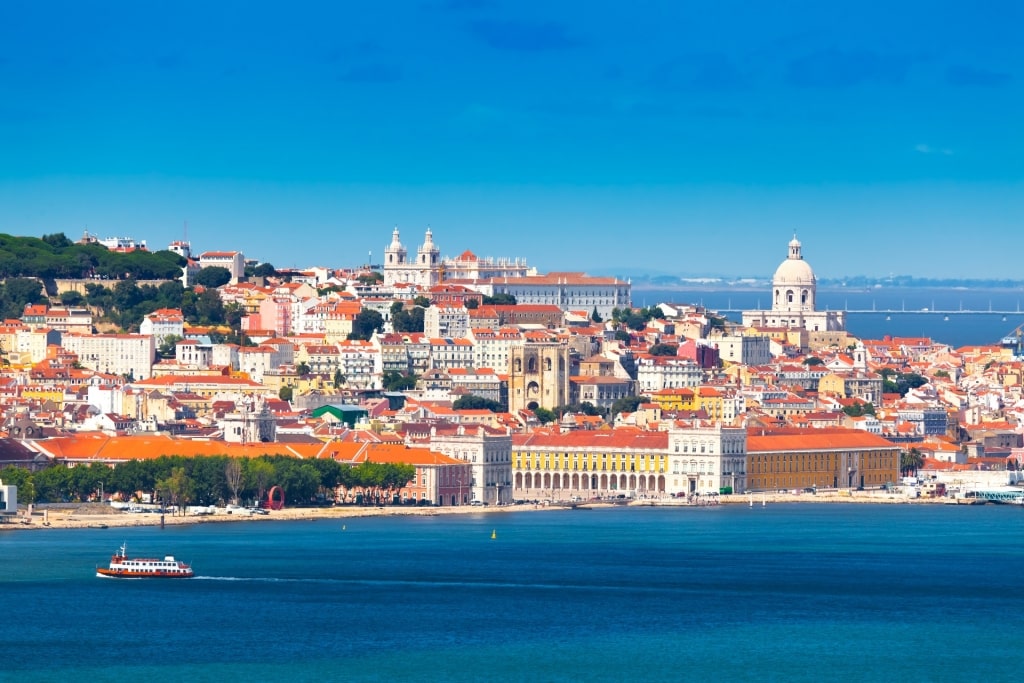
Lisbon
Eager to explore Lisbon’s oldest quarters and quirkiest corners for yourself? Browse Celebrity’s cruises to Lisbon to start planning your next vacation.
